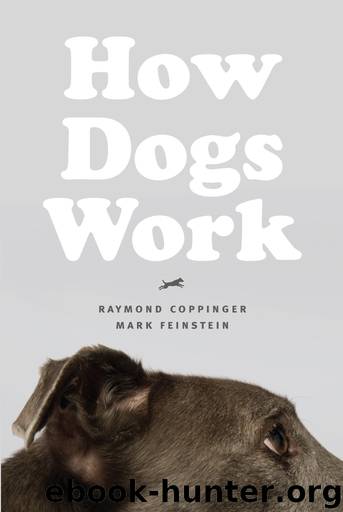How Dogs Work by Raymond Coppinger & Mark Feinstein & Mark Feinstein

Author:Raymond Coppinger & Mark Feinstein & Mark Feinstein [Coppinger, Raymond]
Language: eng
Format: epub
ISBN: 9780226322704
Publisher: The University of Chicago Press
Published: 2015-09-23T16:00:00+00:00
Fig. 28 Four of the great dog behaviorists. John Paul Scott (marked by arrow) is in the center, with Bonnie Bergen on his right and Benson Ginsberg on his left. The lady well back and to the left of Ben is Mary-Vesta Marston, who wrote the seminal paper on the critical period for social development with Scott.
In these respects, the acquisition of language in humans is not unlike the development of social behavior in dogs. Since the mid-twentieth century, with the publication of John Paul Scott and John L. Fuller’s now-classic book on the genetic basis of dog behavior, biologists have understood that canids have a critical period for social bonding and socialization—how animals recognize and interact with one another (fig. 28).
Just how long it lasts, and what animals are sensitive to during this period of growth, remain the subject of lively debate and research. Basically, it’s a matter of how dogs come to deal with other animals as well as novel objects and events in their environment. Exposure to novelty during the critical period results in long-term familiarity and a lack of (or reduced) fear or avoidance responses. Socialization in the critical period no doubt also plays a role in the development of proper species identification in wild canids. And in captive animals (and house pets), exposure during this period to other species such as humans can result in interspecies social attachment, not unlike the imprinting phenomenon that Lorenz discovered.
Kathryn Lord has argued that the critical period for socialization in dogs begins at four weeks with the ability to approach and investigate environmental novelties and ends at eight weeks with the avoidance of novelty. Scott and Fuller suggested that the offset of this critical period in dogs is later, perhaps at twelve weeks. Their conclusion may be due to differences in the breeds that were studied, idiosyncratic individual differences, or simply differences in observation and measurement.
Interestingly, Lord found that dogs and wolves alike have a four-week critical period for socialization—but the onset in wolves is two weeks earlier than in dogs. “In itself,” Lord says, “the earlier progress of wolves than dogs through the critical period for socialization does not explain . . . behavioral differences between dogs and wolves.” But she also realized that the two canids develop their sensory capabilities (vision, audition, and olfaction) at the same time. They can smell very early in life, though sight and hearing are not fully mature until about six weeks. This is in the middle of the dog’s socialization period—but after its offset in wolves. “The consequence of this,” she observes, “is that dogs began to explore the world around them at four weeks of age with the senses of sight, hearing, and smell available to them, while wolves began to explore the world at two weeks of age when they had the ability to smell but while functionally blind and deaf. . . . During the critical period for socialization, therefore, dogs have all of their senses available, while
Download
This site does not store any files on its server. We only index and link to content provided by other sites. Please contact the content providers to delete copyright contents if any and email us, we'll remove relevant links or contents immediately.
| Amphibians | Animal Behavior & Communication |
| Animal Psychology | Ichthyology |
| Invertebrates | Mammals |
| Ornithology | Primatology |
| Reptiles |
Sapiens: A Brief History of Humankind by Yuval Noah Harari(13079)
The Tidewater Tales by John Barth(12039)
Do No Harm Stories of Life, Death and Brain Surgery by Henry Marsh(6343)
Mastermind: How to Think Like Sherlock Holmes by Maria Konnikova(6253)
The Thirst by Nesbo Jo(5795)
Why We Sleep: Unlocking the Power of Sleep and Dreams by Matthew Walker(5659)
Sapiens by Yuval Noah Harari(4553)
Life 3.0: Being Human in the Age of Artificial Intelligence by Tegmark Max(4521)
The Longevity Diet by Valter Longo(4454)
The Rules Do Not Apply by Ariel Levy(3915)
The Immortal Life of Henrietta Lacks by Rebecca Skloot(3833)
The Body: A Guide for Occupants by Bill Bryson(3818)
Why We Sleep by Matthew Walker(3782)
Animal Frequency by Melissa Alvarez(3762)
Yoga Anatomy by Kaminoff Leslie(3713)
Barron's AP Biology by Goldberg M.S. Deborah T(3636)
The Hacking of the American Mind by Robert H. Lustig(3588)
All Creatures Great and Small by James Herriot(3527)
Yoga Anatomy by Leslie Kaminoff & Amy Matthews(3407)
